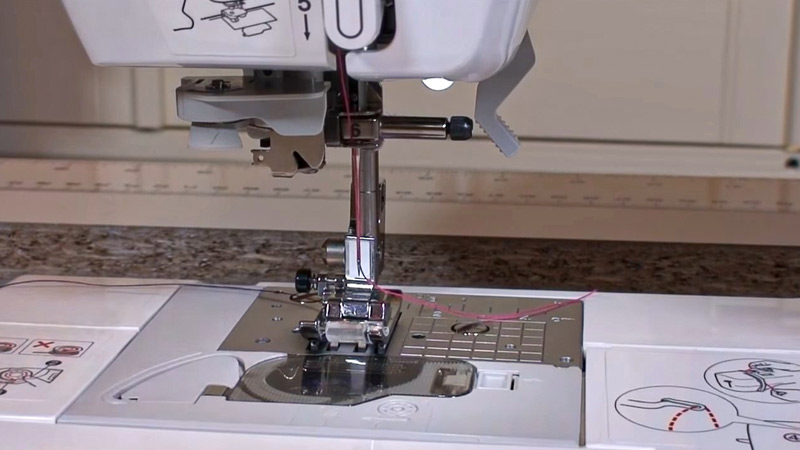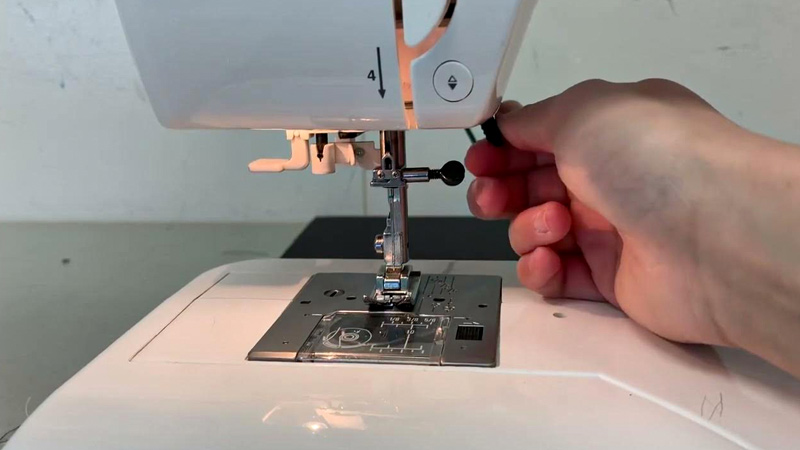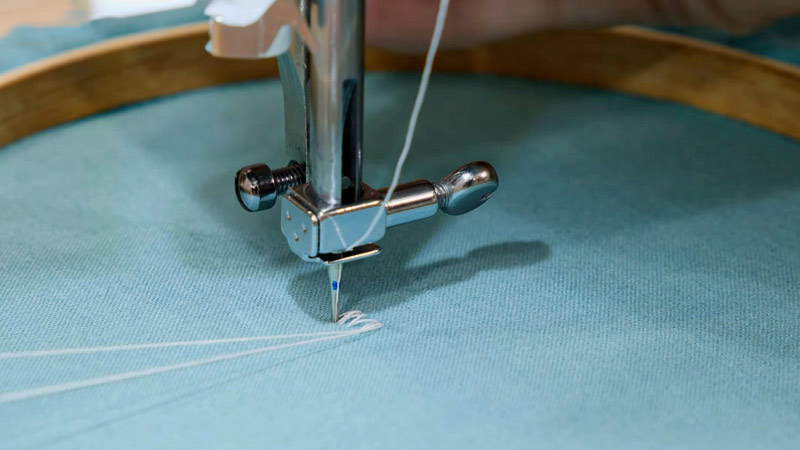Embarking on a sewing journey, understanding the intricate components of your machine becomes paramount.
Among these, feed dogs emerge as unsung heroes, quietly influencing the precision and quality of your stitches.
Nestled beneath the needle plate, these metal teeth are pivotal in orchestrating the seamless dance between fabric and needle.
In this realm of textile craftsmanship, the question arises: Are feed dogs important on a sewing machine?
Unveiling their significance unravels a narrative of stitch consistency, fabric control, and the delicate balance between automation and manual finesse.
Let’s explore why these unassuming components stand as vital pillars in the artistry of sewing.

What Are Feed Dogs on a Sewing Machine and How Do They Work?
Feed dogs on a sewing machine are mechanical components designed to move the fabric through the machine during the sewing process. They consist of a set of metal teeth located below the needle plate.
The primary purpose of feed dogs is to grip the fabric and advance it in synchronization with the sewing machine’s needle, facilitating a smooth and even stitching process.
Here’s how feed dogs work:
Mechanical Movement
Feed dogs are connected to a mechanism within the sewing machine. This mechanism controls the movement of the feed dogs, causing them to rise and fall in a specific pattern.
Synchronization with Needle
The movement of the feed dogs is coordinated with the up-and-down motion of the sewing machine’s needle. The feed dogs move forward when the needle is up, gripping the fabric.
The feed dogs retract as the needle moves down, allowing the fabric to stay in place.
Interaction with Presser Foot
Feed dogs work in tandem with the presser foot, which holds the fabric down against the feed dogs. The presser foot ensures that the fabric is in contact with the feed dogs, allowing them to move it forward during the sewing process.
Adjustable Speed
Many sewing machines allow you to adjust the speed of the feed dogs. This adjustment influences how quickly or slowly the fabric is moved through the machine, affecting the overall stitch length.
Are Feed Dogs Important on a Sewing Machine?

Yes, feeding dogs is crucial on a sewing machine. These metal teeth beneath the needle plate grip and move the fabric in tandem with the needle, ensuring smooth and even stitches.
Feed dogs prevent fabric bunching and slippage and contribute to precise stitching. They coordinate with the presser foot, allowing for consistent fabric advancement.
While essential for regular sewing tasks, feed dogs can be disengaged or covered for specialized techniques like free motion quilting or embroidery, where manual fabric control is desired.
Overall, feed dogs are integral to achieving quality and uniform sewing results.
Why Are Feed Dogs Important in a Sewing Machine?
Feed dogs are critical components in a sewing machine for several reasons. These metal teeth beneath the needle plate are pivotal in guiding and advancing fabric during the sewing process.
Their importance lies in:
Consistent Stitching
Feed dogs work in tandem with the machine’s needle, ensuring a uniform and even stitch formation. This consistency is vital for creating professional-looking seams.
Preventing Fabric Issues

They prevent common fabric-related problems such as bunching, slipping, or uneven feeding. This helps maintain the integrity of the sewing project and avoids disruptions in the stitching flow.
Efficient Fabric Handling
Feed dogs streamline the sewing process by automatically moving the fabric forward, reducing the need for manual intervention. This makes sewing more efficient and less labour-intensive.
Stitch Length Control
The speed and movement of the feed dogs can be adjusted, allowing for control over the stitch length. This versatility is essential for adapting to different fabrics and sewing requirements.
Enhanced Precision
With feed dogs in action, the fabric is held securely in place during stitching, contributing to the overall precision of the sewing process. This is particularly crucial for intricate or detailed sewing projects.
Can You Sew Without Feeding Dogs on a Sewing Machine?
You might choose to sew without feed dogs in specific situations or sewing techniques that require manual control over fabric movement.
Here are some instances when you might sew without feeding dogs:
Free Motion Quilting
In free-motion quilting, you move the fabric in any direction under the needle to create decorative patterns. To do this effectively, you often lower or cover the feed dogs. This allows you to have complete control over the fabric’s movement.
Embroidery

You may need to lower or cover the feed dogs when using decorative stitches to create designs on fabric, especially with an embroidery foot. This enables you to freely move the fabric in different directions as you embellish it with embroidery.
Buttonhole Making
Creating buttonholes involves sewing back and forth over a slit in the fabric. You may need to lower or cover the feed dogs to accomplish this without the fabric being automatically advanced. This allows you to control the movement manually.
How to Lower or Cover the Feed Dogs on Your Sewing Machine?
Lowering or covering the feed dogs on your sewing machine depends on the model; not all machines provide this feature.
Here are some general methods you can try:
Locate the Feed Dog Control
Find the lever, knob, or switch that controls the position of the feed dogs on your sewing machine. This control is usually situated near the needle plate or on the back of the machine. Refer to your machine’s manual for the exact location.
Adjust the Feed Dog Control
Once you’ve identified the feed dog control, adjust it to the appropriate setting to lower or disengage the feed dogs.
This action allows you to move the fabric manually during sewing. Follow the instructions in your machine’s manual for the correct adjustment.
Check for a Plate or Cover
See if your sewing machine includes a special plate or cover designed to conceal the feed dogs. This accessory is often provided with the machine or can be purchased separately. Attach the plate or cover according to the manufacturer’s instructions.
Use Tape or Cardboard as an Alternative
You can create a makeshift solution if your machine doesn’t have a built-in option or specialized cover. Cover the feed dogs with masking tape or place a piece of cardboard over them.
Ensure that the tape or cardboard doesn’t interfere with the needle’s movement or cause any damage to the machine.
FAQs
Are feed dogs adjustable?
Yes, many sewing machines allow you to adjust the speed or pressure of feed dogs, influencing the stitch length and accommodating different fabric types.
Can you sew without feeding dogs?
Yes, feed dogs can be lowered or covered in specific techniques like free-motion quilting or embroidery to allow manual fabric control.
Do all sewing machines have the option to lower or cover feed dogs?
No, not all machines have this feature. Higher-end models often include a lever or knob, while some machines may require alternative methods like using a plate or cover.
Can feed dogs be damaged or cause issues with sewing?
Yes, improper use or damage to feed dogs can result in sewing problems. Following the manufacturer’s guidelines is essential to avoid issues and ensure longevity.
To Recap
Feed dogs emerge as indispensable conductors in the symphony of stitches, guiding fabric through the sewing machine with precision.
As we conclude our exploration into their importance, the answer is clear: feed dogs are not mere mechanical elements but guardians of stitch quality and seam perfection.
Their collaboration with the presser foot choreographs a dance of stitches, ensuring fabric advances flawlessly.
While their constant presence ensures even seams and controlled stitching, the flexibility to disengage them introduces a realm of artistic possibilities.
Whether sewing with steadfast precision or unleashing creativity in free-motion techniques feed dogs remain integral, marking their place as silent yet vital contributors to the artistry of sewing.
Leave a Reply